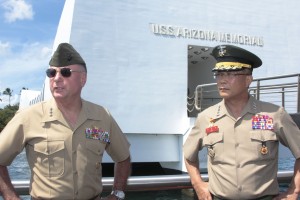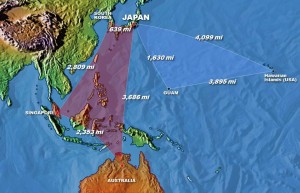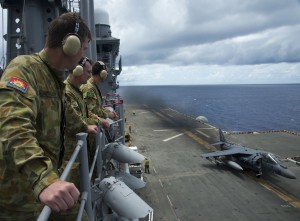2012-09-29 In an interview with Second Line of Defense, the highest ranking Marine in the Pacific discussed the challenges facing the United States as it reset policies in the Pacific.
In the interview,Lt. General Terry “Guts” Robling, Commander, USMC Forces Pacific, focused on the key contribution of the USN-USMC team in the Pacific to what he called, persistent presence.

The “tyranny of distance” in the Pacific makes crafting persistent presence a major challenge.
But the demand side of working with partners and allies in the littorals required the ability to do so.
Crafting capabilities for persistent presence in spite of the geographic and deployment challenges is a key element in shaping a 21st century Pacific strategy.
Lt. General Robling underscored the importance of persistent presence.
The United States has been a significant presence in the region throughout the post-war period. And that presence has been significant glue in the region facilitating both security and economic growth. Our allies and partners certainly recognize this and are a looking at new ways to work with us to get that persistent presence.
A key driver of demand is from partner nations, as well as the more obvious allies. South Korea, Japan, Australia and Thailand are certainly core allies, but we have growing demand from and opportunities with Cambodia, Vietnam, India, Malaysia and Indonesia for expanded working relationships.

SLD: What is the challenge of shaping persistent presence?
Lt. General Robling: Distance and Demand. Distance means that I need to have assets forward deployed and operational.
This means for the USMC, an ability to train with partners and allies in what you have called the strategic quadrangle.
This means an ability to have enough capable amphibious ships forward deployed to operate with those partners and allies.
Sebasing is a key element of providing persistent presence.
And amphibious ships are real part of a whole sea-basing capability and engagement capability. The amphibious requirement in the Pacific goes well beyond our support to South Korea. It is a key element in building partnership capacity and overcoming presence gaps and needs. This is why we need more platforms and more capable platforms of the sort we are building now.
Many of our partners in the region do not want us to be the Uncle that visited and never returned home. They want us engaged and present but not permanently based in their countries. This means that seabasing and its augmentation is a fundamental requirement. When we add strategic lift aircraft, high-speed vessels or super ferries to the ARG-MEU lift equation we extend our strategic reach and significantly enhance our ability to enhance partnership capacity.
SLD: Could you talk to the challenge of distance to providing for presence?
Lt. General Robling: To get from Hawaii into the strategic triangle or quadrangle takes significant time. Between Hawaii and Okinawa is about 5 steaming days. It is longer to get to Australia and Guam and then back up to Okinawa and Tokyo within the Quadrangle.
Strategic aircraft lift – C-17s – cuts that time down significantly…hours vice days. However, they are expensive to use, take several sorties to move the same amount of equipment you could move on shipping and are not always available.
Our strategic partners and allies are spread out over a significant geographical area. They want to train with us , but not always bilaterally, they sometimes want us to work with them and some or several of their partner countries. That means we must take the training to them. This adds further challenges to the persistence equation and in turn, makes available amphibious lift even more important.
SLD: Obviously basing is a challenge as well. Could you talk about the roles of the new working relationship with Australia as well as Guam in facilitating presence?

September 14, 2012
Lt. General Robling: You need places to train the MAGTF within the Pacific. This means ranges large enough to train all of the elements of the MAGTF in a combined setting across the full range of military options. These are hard to find. Australia affords us with ranges where we can do that type of training. While training in Australia, we are looking at using rotating units in and out periodically. We will rotate them in during the dry season when the terrain is viable for mobility, and we will rotate them out during the wet season to other areas in the Pacific when it is impossible to train or move due to terrain saturation or flooding.
Guam ranges will not be quite as large or well defined. We will have to find some unique ways to get after all the unit training METLs in and around Guam and the outer islands while linking in combined fires and effects where we can. I am confident we will find ways to get the training done we are required to do and due to its location, Guam becomes an important basing option for a balanced MAGTF.
Amphibious ships will be a key element to the Australian working environment.
Due to Australian agricultural, quarantine and inspection requirements, it will be more cost effective in both time and money to preposition some equipment ashore, but have equipment on the amphibious ships we can use to train in other areas of the Pacific, and avoid the necessary restrictions.
SLD: The USN-USMC team is to receive an additional ARG-MEU sometime in the next decade. There has been some talk about putting this ARG-MEU in San Diego and giving this a 90 deployment window. Isn’t this a bit challenging from a tyranny of geography point of view?
Lt. General Robling: It is. If we put it in Hawaii or Guam, it is much closer to the countries we will work and interact with. Having amphibious ships forward deployed means less response time in a crisis and more visibility, interaction and partnering opportunities when crisis are not present.
SLD: You have worked on Marine Corps aviation all of your life, and have been intimately involved with the F-35. Indeed, the first F-35 squadron to be based in Yuma will come to the Pacific as early as 2014.
How can the allied F-35s work with yours to shape a new Pacific capability?
Lt. General Robling: In two ways.
First, we would have common or like support structures. This will increase are forward readiness posture by being able to fix and maintain aircraft that are deployed vice send them back to the states for repair or reach back to the US for parts. The more allies who buy the aircraft the more spread out that support structure would be.
Second, the capability of the aircraft as a C5ISR platform will allow significant sharing information sharing and fusion to more of our partners who are able to receive and use the information. This increases our persistent presence capability. The aircraft will help fill in capability gaps or seams between us and our partnering countries and in the end, help build or increase their own capacity.
(For a discussion of the strategic triangle and quadrangle see the following:
https://sldinfo.com/geography-presence-and-a-21st-century-pacific-strategy/
Seen below is the USS Wasp during the RIMPAC 2012 Exercise
RIMPAC 2012: USS Wasp from SldInfo.com on Vimeo.

